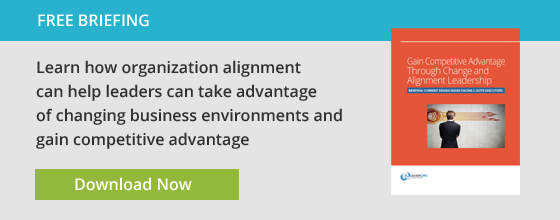Building on our recent post about the costs of a misaligned culture and what to do about it, today I want to go deeper and talk about the vital link between strategy, culture, and actions.
Even if a culture fully aligns with an organization’s strategy, individual choices can weaken that culture and thus hinder its ability to support the achievement of strategic goals. To prevent this from happening, alignment leaders will want to address decisions being made across the organization as they relate to culture, using a three-step approach.
Step 1: Evaluate
Look at the decisions being made across the organization and evaluate how closely they align with the culture you aim to promote. For example, accountability may be one of the attributes you want to cultivate … but upon examining your daily operations, you might find a lack of set processes and procedures, with every team member acting as he or she sees fit.
As you consider solutions to resolve the gaps between your culture and your day-to-day actions, keep in mind that some remedies will be more impactful than others. In addressing the lack of accountability in the example above, an alignment leader could put up posters throughout the building reminding employees to be accountable … or he could put a system of metrics and incentives in place to promote accountable behavior. Would both decisions be helpful? Yes. Would the latter be more impactful? Definitely.
Part of the Evaluate step is to ascertain what is misaligned and the potential impact of those misalignments. Some misalignments will be significant, while others may be cosmetic.
Step 2: Implement
Once you have identified the gaps, engage your leaders in a discussion of how to realign choices, in a cascading fashion, to support the desired culture. The cascading approach is important, as choices being made in the boardroom are fundamentally different from those being made on the shop floor.
When we work with clients on realigning day-to-day actions, we organize working sessions, each involving between 8 and 15 people who represent different aspects of the organization. During these multi-day sessions, we work through the paradigm presented in our book Mastering the Cube, beginning with the organization’s strategy. We then proceed through the various organizing systems (work, structure, information/metrics, people/rewards, continuous improvement, and leadership practices) to identify new choices that will help reinforce the desired culture.
Let’s say that a particular organization’s goal is to deliver the most innovative products on the market. With that goal as a starting point, we look at aspects of the culture that might be blocking the organization from achieving what it has set out to do; maybe it’s a lack of accountability. Then we work through all sides of the Cube to uncover new choices that address these blocking points and create alignment; one of these might be establishing a system of metrics and incentives to promote greater accountability. Another might involve embracing a comprehensive management system, as Toyota did with the Toyota Production System, which provides tools, role responsibilities, and guidance on how to efficiently and effectively perform the key production activities essential to their success.
Step 3: Plan for Continuity
As with any organizational initiative, it’s easy to get people excited about your alignment plan when it’s fresh and new. The challenge is to keep that momentum going once you’ve set it in place.
The key here is establishing a cadence, a rhythm that reinforces the change in the minds of employees. Once that cadence is established, you have a much higher chance of success in building lasting change and ensuring continued agreement between your culture and the daily choices being made across the organization.
As we discussed in our previous post, a culture that is not deliberately shaped can spin out of your control. The occasional misaligned choice may seem like “no big deal” in the short term, but if errant decisions become the rule rather than the exception, it’s time for the alignment leader to step in. By following this three-step approach, you can make people aware of the need to support your organizational culture in their daily work life and guide them in the way of making more closely aligned choices, now and in the future.






